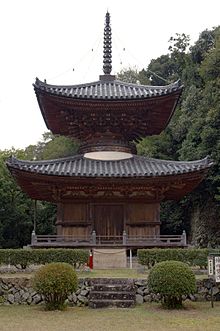Jōmyō-ji (Arida)
The Jōmyō-ji ( Japanese 浄 妙 寺 ) is a temple of the Rinzai direction of Buddhism in the city of Arida in Wakayama Prefecture .
history
According to temple tradition, the temple is said to have been founded in 806 at the request of Fujiwara no Otomuro ( 藤原 乙 牟 漏 ; 760–790), the mother of Emperor Heizei and wife of Emperor Kammu . The temple was opened by the priest Johō ( 如 宝 ) from China . The temple was devastated in the Sengoku period , but the rear temple area in the mountains, the oku-no-in ( 奥 ノ 院 ), with the yakushi hall and the treasure pagoda was preserved.
In 1647, the prince of the province of Kii , Tokugawa Yorinobu ( 徳 川 頼 宜 , 1602-1667) promoted the temple, which was then run by the priest Keizui ( 圭 瑞 ), the founder of Suijō-ji ( 吹 上 寺 ) in the city of Wakayama, the Myōshin -ji was assigned as an outer temple in Kyoto.
The attachment
If you climb the stone stairs, you come to the main hall of the temple, here called Yakushi Hall ( 薬 師 堂 , Yakushi-dō ). It comes from the Kamakura period . Next to it is the Treasure Pagoda ( 多 宝塔 , Tahōtō ), which also comes from the Kamakura period. It has a side length of three ken (approx. 5 ½ m) and is covered with tiles. Both buildings are registered as important cultural assets .
Treasures of the temple
Inside the Yakushi hall there is an altar from the Kamakura period, the Renge karakusa mon raden shumidan ( 蓮華 唐 草 文 螺 鈿 須弥 壇 ), i.e. an altar ( shumidan ), the one with lotus ( renge ) and grass ( karakusa ) in mother-of-pearl ( raden ) decorated ( mon ) is. On the altar there is a Yakushi Buddha, who is accompanied by two guards and protected by the twelve heavenly generals . The altar and sculptures are registered as important cultural assets.
A Gochi Buddha ( 五 知 如 来 ) is set up inside the pagoda . The “Eight Fathers of Enlightenment” ( 八 祖 成 道 , Hasso jōdō ) are painted in the four corners . The "Eight Fathers of Shingon " ( 真言 八 祖 , Shingon hasso ) are painted behind the altar . Both are important cultural assets of the prefecture.
literature
- Wakayama-ken kotogakko shakai-ka kenkyu-kyokai (Ed.): Jōmyō-ji. In: Wakayama-ken no rekishi sampo. Yamakawa Shuppan, 2009, ISBN 978-4-634-24630-0 , p. 153.
Web links
Coordinates: 34 ° 4 ′ 34.5 ″ N , 135 ° 6 ′ 52.7 ″ E

